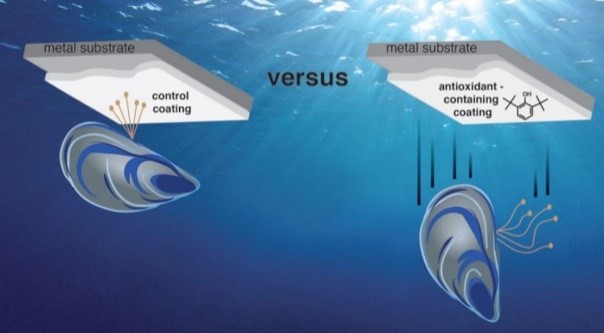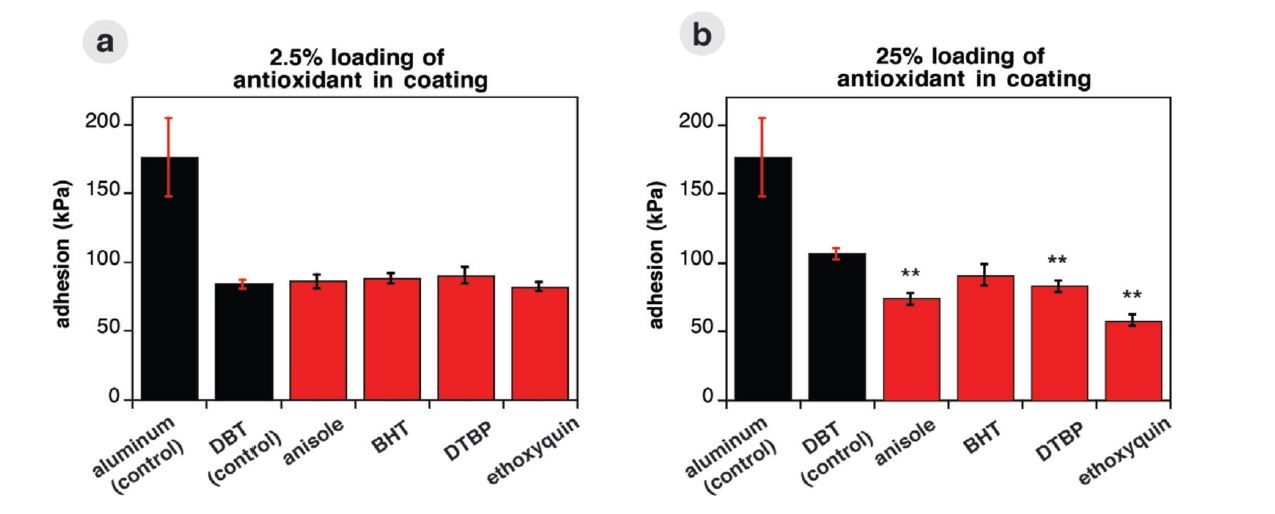|
利用抗氧化机理抑制生物粘附的涂层技术
图1. 含抗氧化物质涂层对比普通涂层可以降低生物黏性作用
图2. 4种抗氧化物质与对照组DBT
图3. 实验设施与方案
图4. 不同抗氧化物质及抗氧化物质的含量对黏附强度的影响 Chem. Mater. 2016, 28, 6791−6796. 近年来,针对海洋贻贝类生物黏附特性的研究,发现了贻贝黏附蛋白中产生黏性的机理是3,4-二羟基苯丙氨酸(DOPA)结构的存在,其可通过氧化作用产生醌式结构,以化学键合的形式固定在物体表面而产生强力的黏性。利用这种黏附机理,DOPA结构广泛应用于材料表面的改性。例如对生物材料的表面预处理后,可以进一步将生长因子等生物活性物质固定于材料表面。然而,其可以对几乎任意表面黏附,在实验、生产过程中,如何避免其广泛的黏附特性是一个艰巨的任务。类似的问题同样出现在远洋运输中,由于海洋生物(诸如藤壶,牡蛎,贻贝等)黏附于轮船底部,产生的阻力使轮船消耗了更多的燃料。而传统方法是通过船底的涂料向周围水环境中释放有毒的铜离子(Cu2+),对海洋的污染和海洋生态环境的破坏是非常严重的。因此研制出新型环境友好型抗黏附涂层材料具有重要的意义。 在氧化的作用下,DOPA结构会转化为醌式结构进而与物体表面化学键合形成强力的连接。因此理论上具有抗氧化性的物质(还原剂,抗氧化剂等)可以减弱甚至阻止DOPA的氧化,从而减弱其黏附性。美国普渡大学的Del Grosso等人设计了4种抗氧化材料,将其与涂料按比例混合,涂覆于铝板上。将贻贝固定于涂有不同材料的铝板上培养一定时间后,移除贻贝,测试贻贝分泌的黏性物质与底板材料的粘结力和贻贝的生理健康状况。通过此项实验研究抗氧化材料对黏附的影响。实验结果表明,包括DBT对照组在内的所有涂层上贻贝黏附蛋白的黏附强度要比空白铝板要低。含2.5%抗氧化物质的涂层,各涂层上黏附蛋白的黏性相近;而含有25%抗氧化物质的涂层,可以观测到黏附蛋白的黏性显著降低,并且各物质对贻贝的生理健康几乎没有影响。该类抗氧化物质起到了明显地减弱黏附蛋白黏性的作用,并且对周围生态环境无明显影响。 Recently, the bioadhesive properity of marine mussels have been extensively studied, and the mechanism has been found that all the adhesion proteins contain a kind of rare amino acid 3,4-dihydroxyphenylalanine (DOPA). This component can be oxidized by one electron to a semiquin one or two electrons to a quinone. Subsequent reactivity generates the final cross-links with the surface of materials. With this properity, DOPA and its derivative structure have been utilized to modify the surface properities of materials. For example, after DOPA pre-treatment, the growth factors and other bioactive substance could effectively attach to the surface of biomaterials. However, with the ability to attach onto nearly any surfaces, how to avoid the unnecessary attachment of DOPA is a arduous task. Besides, for marine organisms, such as barnacles, oysters, mussels, etc., they often attach themselves to underwater structures. This adhesion presents a major problem for transoceanic shipping. Because of the resistance that caused by the attachment of marine organisms, fuel burn can increase up compare to a clean hull. Traditionally, coatings releasing biocidal copper(Cu2+)into the surrounding waters could stop attachment by essentially killing everything in the waters around a ship, which severely caused the pollution of the ocean and the destruction of the marine ecological environment. Therefore, it is of great significance to develop a new type of environmentally friendly anti-bioadhesion coating material. DOPA can be oxidized to a semiquinone or a quinone which subsequently generates the chemical bonding with the surface of materials to form a strong connection. Such insights now allow us to take a mechanism-based approach to minimizing or stopping oxidation reactions of DOPA necessary to form glues and thus the bioadhesion could be weaken. Del Grosso et al., from Purdue University, United States, designed a protocol that 4 kinds of antioxidants and a control compound were each dissolved into a host coating proportionally and painted onto aluminum panels. Mussels were each banded to panels containing different antioxidants as well as bare, uncoated aluminum for comparison. After 3 days culture underwater, adhesion strengths were quantified after animals were removed from the plates, leaving behind attached plaques and threads on the coatings, also did the mussel health. The effect of antioxidant materials on adhesion was studied throughy this experiment. Results showed that average adhesion strength values for mussels attached to each coating containing an antioxidant (or DBT control) displayed less adhesion than the bare, uncoated aluminum control. At 2.5% loadings of antioxidants in the host matrix, animals stuck equally well to all surfaces. With more antioxidants present at 25%, significant decreases in adhesion were found, relative to the DBT control. These tests also revealed that the candidate coatings did not diminish mussels’ health. These kinds of antioxidant substances have a significant effect on reducing the attachment ability, and have no obvious influences on the surrounding ecological environment. (李林龙) |



